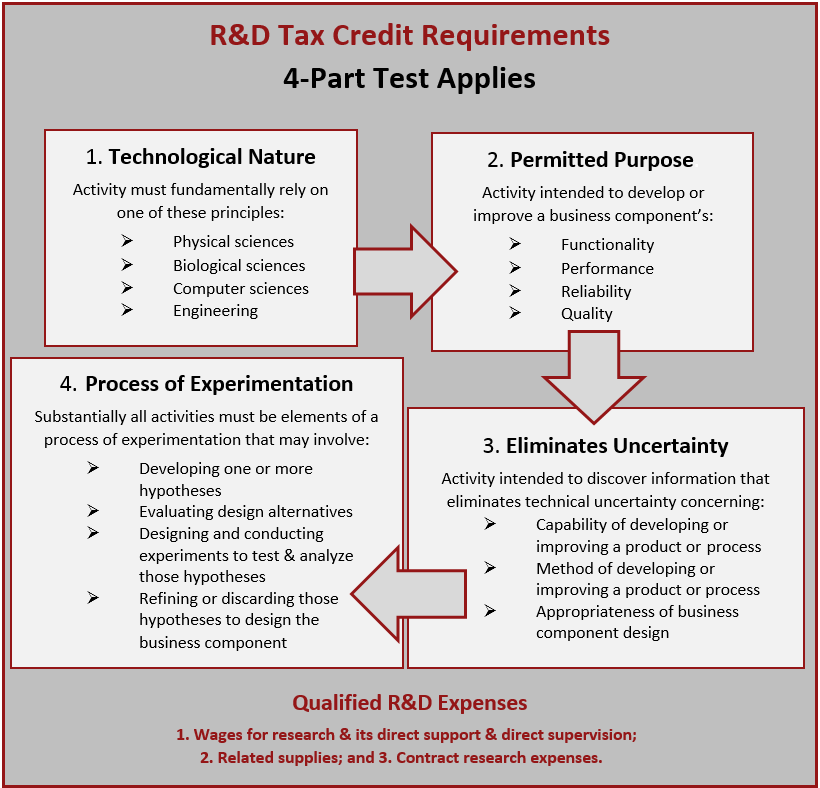How R&D Tax Incentives Can Boost Sales
R&D Tax Credits
Make You More Competitive
Maybe you’ve heard the government has loosened the requirements and broadened the benefit for claiming research and development (R&D) tax credits.
Before you decide your company isn’t eligible for these credits, you should know you may be missing out on hundreds of thousands or even millions of dollars straight to your bottom line by dismissing this too quickly. The name itself is deceptive, as many basic manufacturing, telecom, construction, engineering and architectural, even some farming activities may qualify – in addition to the more obvious software, biotech and other high-tech industries.
The list below reflects some of the less-than-glamorous manufacturing sub-sectors to illustrate this point. Note the amount of tax credits they’re averaging…
Many business activities involved in the design and manufacturing of both physical and digital products now qualify for generous tax credits – and credits are far more valuable than tax deductions because every penny falls straight to your bottom line (whereas with deductions, only the percentage equal to your tax bracket falls to your bottom line).
So it’s worth a few minutes of your time to see whether your business actually qualifies after all – especially now that, for the first time, it’s both easier and more lucrative to apply for these tax credits. Until recently, it was only practical to claim credits for the current filing year. However, businesses can now claim credits for up to four years of payroll costs.
The average credits in the above table don’t reflect this change, so the total credit amounts now and going forward could be substantially higher.
R&D Tax Credits Are All About JOBS
The way it works is this: Governments adopt R&D tax credits to encourage businesses to keep technologically-oriented jobs in their jurisdiction. The U.S. has had such a program since 1981 and it’s been expanded ever since as one of very few programs enjoying broad bipartisan political support.
Most states also offer parallel tax credit programs that often exceed the federal tax benefit. The combination often makes this the most lucrative tax break currently available.
Here are the basics for considering whether any of your employee activities might qualify for R&D tax credits:
R&D as a Competitive Weapon
But if the financial rewards to your bottom line aren’t enough, there are also some less obvious top line benefits to securing R&D tax credits for your business.
One of these is the ability to bid more aggressively on projects that may include activities that qualify for R&D tax credit treatment.
Work performed for clients may still produce tax credits for your business if it improves a product or process for them even though your business is being paid to perform that work.
Knowing this, you may be willing to bid more aggressively for projects you might otherwise pass on or lose out on with a higher bid.
This is a distinct market advantage that could help you secure more business without losing margin on an after-tax basis (meaning any margin deterioration would be more than offset by the tax credit savings).
Adding this tool to your marketing toolbox could be the extra boost needed to grow both your top and bottom lines.
R&D May Increase Your Business Value
Qualifying for R&D tax credits creates a valid paper trail and credential that your business engages in highly-valued product and/or process innovations.
Companies involved with R&D routinely command higher valuations in merger and acquisition activity, as well as in project funding from virtually all sources.
While you may not have any active exit planning underway at the moment, it’s always nice to be able to rely on an optimal valuation for whatever exit path you may ultimately pursue. It also helps with any other financing you may want or need to grow your business before then.
That all adds up to quite a compelling set of reasons to at least explore whether your business may qualify for these lucrative tax credits – or perhaps additional tax savings that many businesses also qualify for…
- More cash
- Stronger P&L and Balance Sheet
- Improved Earnings Per Share
- More Job Security
- More Sales Revenue with Bid Subsidies
- More Prestige and Higher Business Valuation.
To see what tax savings your business may qualify for – in minutes – click here.
To learn more, contact us.

